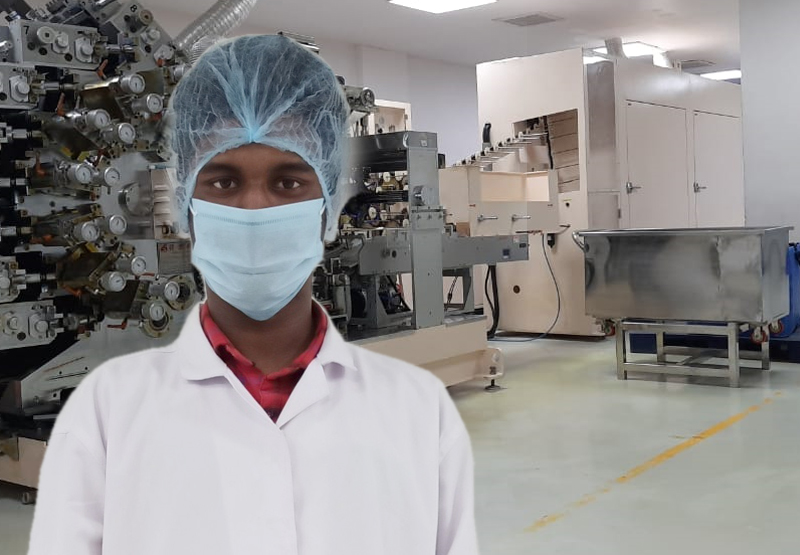

Pharmaceutical manufacturing is always done in clean and controlled environments. Hence even the supply chain partners like those who supply packaging materials to pharma companies have to maintain the highest standards in ensuring that the relevant hygiene, care, cleanliness and microbe-free environment is present while producing such packaging materials.
Parekhplast is a reputed supplier of rigid plastic packaging materials to pharmaceutical and nutraceutical companies in India and the world. A Venkateswara Rao, Sr Manager – Quality describes the various aspects of cleanrooms in this article and how it is used in ensuring a quality product in Parekhplast.
What is cleanroom?
A cleanroom is a controlled manufacturing environment where pollutants like dust, airborne microbes, and aerosol particles are filtered out in order to provide the cleanest area possible. Most cleanrooms are used for manufacturing products such as electronics, pharmaceutical products, and medical equipment.
Cleanrooms are classified into different levels depending on the amount of particles allowed in the space, on a per cubic meter basis. Cleanrooms also control variables like temperature, air flow, and humidity.
How do cleanrooms work?
Essentially, cleanrooms work to remove pollutants, particles, and contaminants from outside ambient air. Outside air is first circulated to a filter system. The filters (either HEPA or ULPA) then clean and decontaminate this outside air according to their specifications. The filtered air is then forced into the cleanroom. Additionally, contaminated air within the cleanroom is forced outside the room by registers, or it is recirculated back into the filters, and the process restarts.
What are the different levels of classification of cleanrooms?
Cleanrooms are classified according to the number and size of particles permitted per volume of air. Ie simply speaking, they are classified by how clean the air inside the room is.
In Federal Standard 209 (A to D) of the USA, the number of particles equal to and greater than 0.5µm is measured in one cubic foot of air, and this count is used to classify the cleanroom.
The cleanroom classification standards FS 209E and ISO 14644-1 require specific particle count measurements and calculations to classify the cleanliness level of a cleanroom or clean area.
Why is this environment important for pharma packaging?
The basic function of the cleanrooms in Pharma industry is to protect the manufactured products from contamination. The contaminations are usually generated by humans, processes, facilities and equipment and they must be removed from the air.
The level of air cleanliness in the Pharmaceutical cleanroom are therefore regulated by standards like ISO 14644 so that the concentration of airborne particles in the manufacturing environment is controlled to specified limits.
Usually, ISO Class 5 to 8 are recommended in pharmaceutical manufacturing.
How does one maintain continuous monitoring of cleanroom during production of packaging? What are the control parameters?
One has to control various factors which can affect the clean production environment as under:
i) Monitoring active cleanroom surfaces:
All surfaces, including walls, floors as well as those on equipments should be monitored and cleaned regularly. It is necessary to regularly take the count of viable particles through contact plates in order to be alert on contaminants.
ii) Monitoring of Humans working on the shopfloor
Humans entering the manufacturing area may be a significant carrier of contaminants and hence careful procedures are required to be followed.
Each personnel has to wear Personal Protective Equipments (PPE), foot covers, have a proper gowning routine, hand hygiene through IPA / other solutions, face mask , gloves and head covers in order to ensure minimal skin contact with the items being manufactured within the area. These are to be freshly taken just while entering the clean area which is usually segregated with a break-barrier
iii) Regular checks on air within the clean room area
Various parameters like Temperature, Air pressure, Humidity are regularly monitored even though the air in the facility is controlled by the HVAC systems. Air samplers must be maintained for monitoring particle counts too. Data records need to be maintained for this purpose and regularly monitored.
How does Parekhplast handle this withing its plants?
Parekhplast, being a manufacturer of plastic packaging materials for the pharmaceuticals and the nutraceutical industry has to follow ISO Class 8 Cleanroom (formerly Class 100,000) environment in its manufacturing area.
Hence it has ensured the creation, maintenance, and monitoring of such an environment in all factories and areas where such goods are manufactured. Not only does Parekhplast ensure this within, but it also has the same checked and certified by an external agency.
Humidity and Temperature of the environment is monitored periodically within the plant. Air pressure within the clean zone is monitored through pressure / megnehlic gauges. Maintaining of positive pressure flow from clean to unclean areas is done by the Air Handling Unit Control System (AHU).
Strict procedures are followed for entry and exit of humans and materials. It has appropriate barrier-breakers to cordon off the cleanroom, through transition areas for ensuring this. No eating, chewing gum, etc is allowed inside the cleanroom and cosmetics and jewellery is prohibited. Regular cleaning of active surfaces is done with relevant SOPs.
Parekhplast facilities are regularly audited by external agencies. They are also inspected and audited by our clients and they have always found the same to the best of their expectations.

About A Venkateswara Rao
A Venkateswara Rao is the Senior Manager – QC & QA at the Hyderabad facility of Parekhplast. He is passionate about his work, highly organized, and system-oriented with an eye for detail. He keeps himself abreast of the latest developments in his work and motivates his team members also accordingly.